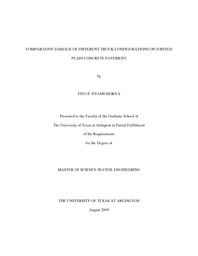
ATTENTION: The works hosted here are being migrated to a new repository that will consolidate resources, improve discoverability, and better show UTA's research impact on the global community. We will update authors as the migration progresses. Please see MavMatrix for more information.
Show simple item record
| dc.contributor.author | Nyamuhokya, Tito P. | en_US |
| dc.date.accessioned | 2009-09-16T18:19:46Z | |
| dc.date.available | 2009-09-16T18:19:46Z | |
| dc.date.issued | 2009-09-16T18:19:46Z | |
| dc.date.submitted | January 2009 | en_US |
| dc.identifier.other | DISS-10372 | en_US |
| dc.identifier.uri | http://hdl.handle.net/10106/1781 | |
| dc.description.abstract | This study estimated the damage done by trucks with 35 different configurations on a typical structure of a Jointed Plain Concrete Pavement. The configurations were proposed by New York Department of Transportation, the sponsor of this study. The generalized three dimensional finite element program Abaqus was used to calculate the response of linear elastic rigid pavement structure under truck loading. The loads for each truck case were placed at critical locations on the surface of the pavement to obtain the maximum tensile stresses at the bottom of concrete slab. The computed tensile stresses were used in Darter fatigue model (1977) to calculate for each truck case the allowable number of axles that causes fatigue failure of the concrete pavement. Base on the combination of allowable number of axles for each truck case, relative truck damages were developed and used to compare the damage effects of the 35 truck case configurations on the Jointed Plain Concrete Pavement. The results indicate that the most critical damages to the rigid pavement were caused by truck cases with high and unevenly load distribution and spacing between axles. Other results included are: (1) increase in damage when loads were shifted between same size axles, (2) decrease in truck damage when loads were shifted from tandem axle to quad axle, (3) decrease in truck damage when spaces were increased between axles of a quad axle, and (4) increase in truck damage when, within a group of axles, the axles were moved from equally to unequally spaced. Another analysis tool which was used in this research to compare trucks base on the performance of rigid pavement was the Mechanistic Empirical Design Guide (MEPDG). The guide has software which was used to calculate bottom up transverse cracks on the pavement caused by 10 out of the 35 truck cases proposed by NYSDOT. Other truck cases could not be analyzed by the software because the trucks axles were unequally loaded and spaced. The MEPDG analysis on the 10 truck cases indicates the same trend of truck damages as the Finite Element analysis on the same truck cases when truck axle types and/or loads positions were changed. However the effect of changing the truck configuration and axle loads on the damage ratios computed by the MEPDG software was higher than on the ratio predicted from the finite element method. | en_US |
| dc.description.sponsorship | Romanoschi, Stefan | en_US |
| dc.language.iso | EN | en_US |
| dc.publisher | Civil & Environmental Engineering | en_US |
| dc.title | Comparative Damage Of Different Truck Configurations On Jointed Plain Concrete Pavement | en_US |
| dc.type | M.S. | en_US |
| dc.contributor.committeeChair | Romanoschi, Stefan | en_US |
| dc.degree.department | Civil & Environmental Engineering | en_US |
| dc.degree.discipline | Civil & Environmental Engineering | en_US |
| dc.degree.grantor | University of Texas at Arlington | en_US |
| dc.degree.level | masters | en_US |
| dc.degree.name | M.S. | en_US |
| dc.identifier.externalLink | http://www.uta.edu/ra/real/editprofile.php?onlyview=1&pid=2028 | |
| dc.identifier.externalLinkDescription | Link to Research Profiles | |
Files in this item
- Name:
- Nyamuhokya_uta_2502M_10372.pdf
- Size:
- 5.671Mb
- Format:
- PDF
This item appears in the following Collection(s)
Show simple item record


